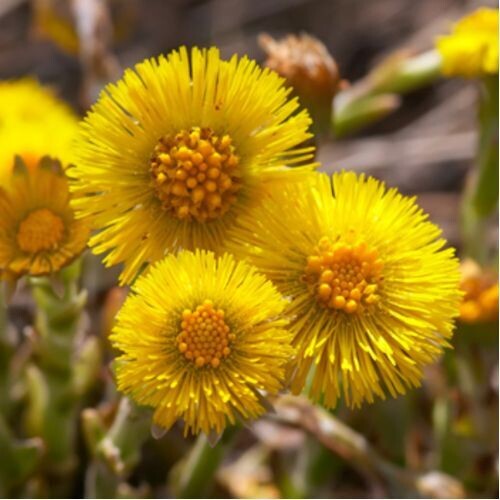Coltsfoot (Tussilago farfara)
Available either as a dried herb or herbal tincture.
Please note this is a nutritional, functional horse food supplement and not veterinary medicine.
See Dr Kellon's Horse Sense - 'Nutrition is not 'Alternative' Therapy
for more information.
Tincture
Our human-grade, certified organic tinctures give you a ready-to-absorb potent source of phytonutrients at the highest-strength available, for immediate absorption straight into the bloodstream and to the body’s cells.
100% certified organic pure tincture: Tussilago farfara (Coltsfoot) Leaf, Infused 1:3 35%, Wild harvested
Feed Guide
- Horse - 30-40ml / Pony - 15-20ml, daily in feed.
- Always shake the bottle to disperse any sediment.
- 3-year shelf-life.
Dried Herb
Certified organic dried herb: Tussilago farfara (Coltsfoot) Leaf , Wild harvested, Origin Poland
Feed Guide
- 5g/100kg bodyweight per day, thus for an average 500kg horse add 25g daily to feed.
- 1-year shelf-life.
Functional Nutritional Value
Constituents: Flowers: mucilage; flavonoids (rutin, carotene); taraxanathin; pyrrolizidine alkaloids (senkirkine, senecionine, tussilagine). Leaves: mucilage; flavonols (quercetin, kaempferol and their glycosides); tannins; inulin; phytosterols (sitosterol, stigmasterol, taraxasterol); sesquiterpene (tussilagone); zinc.
NB. Our range of botanicals are all grown, harvested and dried without the use of agri-chemicals, non-irradiated and GMO free - see our Quality page for Quality Management & Certification Documents. Laboratory tested for identification and compliance to the British and European Pharmacopoeia standards, and are human grade.
Please be aware that if you're purchasing our dried botanicals for human use, our dried range is cut to appropriate sizes for feeding to horses.
More ...
If you were to have visited an apothecary in the 17th/18th Century, you would recognise coltsfoot immediately from the signage outside. The apothecary physicians used the coltsfoot flower as the emblem for their shops, and it’s still used as a logo by many herbalists today. I remember one of my medical herbalist tutors saying that to harvest coltsfoot flowers was heartbreaking, as it was so beautiful.
But harvest the flowers we must, as its generic name Tussilago - with tussis meaning ‘cough’, and ago meaning ‘to cast off’ - gives it the biggest hint towards its medicinal use. It’s probably the best cough herb there is, and we know from Roman times that this herb was one of their go-to remedies for respiratory disorders.
It’s been a renowned antitussive (cough reflex inhibitor) herb for centuries as a prized pulmonary tonic and curative against emphysema, chronic bronchitis and whooping cough, with Culpepper mentioning that “ The fresh leaves, or juice, or syrup thereof, is good for a bad, dry cough, or wheezing and shortness of breath ”. Today’s research supports the historic claims, with its actions being expectorant, antitussive, demulcent, anticatarrhal, and anti-inflammatory.
Like marshmallow and mullein, coltsfoot is jammed full of mucilage, making it an excellent demulcent with expectorant activities. Historically, this meant that many people smoked the flowers to help with coughs (!), with the ancient Greeks and Romans recommending this method. Obviously we now know that this really shouldn’t be the best way to get your coltsfoot fix, although you can still find coltsfoot in a number of herbal ‘tobacco’ blends.
Just like its relative elecampagne ( Inula helenium ), coltsfoot has been used to make cough sweets. Boiled in honey or sugar syrup, coltsfoot was once a popular remedy to alleviate coughs and asthma.
Long and short, coltsfoot strengthens and supports the respiratory system. The fresh leaves, juice and syrup have been used for supporting dry coughs, wheezing and shortness of breath, with its mucilaginous property protecting the throat from irritation, reducing cough frequency and dilating the bronchial passages. It’s specifically indicated for convulsive coughing, or stubborn, irritating coughs.
In Western herbalism, the leaves are considered particularly anti-inflammatory. They’re the part of the plant that are richest in zinc, which is known to support immune function and reduce inflammation in the mucosal tissue.
As an aside, the overall anti-inflammatory action of coltsfoot is reportedly similar to the pharmaceutical NSAID drug Indomethacin . It’s also a mild diuretic and has been used to treat cystitis.
You can even cook with it! The downy leaves can be simmered and blended with onion and potato into a thick soup, or the leaves can be steamed like spinach, then served with a knob of butter.
Tincturing coltsfoot extracts the highest concentration from any given sample, containing 10 times the amount of certain constituents as a tea made of the same amount of herb. Hence why we only produce our KoffTonic in tincture form to maximise the benefits and efficacy.
Safety
- There are no documented adverse reactions recorded for coltsfoot.
The content in this website is intended as a sharing of knowledge and information from our own research over many years, together with clients' experiences and our own personal experience over 5-decades of horse care. This website is about enlightening towards a more naturopathic approach to support a healthy lifestyle for our horses. Any information contained within is not intended as a substitute or replacement of veterinary or other professional advice, and we would encourage everyone to make their own equine healthcare decisions based upon their own research.
* Trading Standards EC Feed Hygiene Regulation (183/2005), Registration No. GB280/4203
* HACCP certified facility (an international standard that ensures we meet food safety standards)
* Registered in England. Company Number 11075894, Reg'd Office: Unit 4 Rookery Farm, Radstock BA3 4UL
* VAT No. GB 310214964


